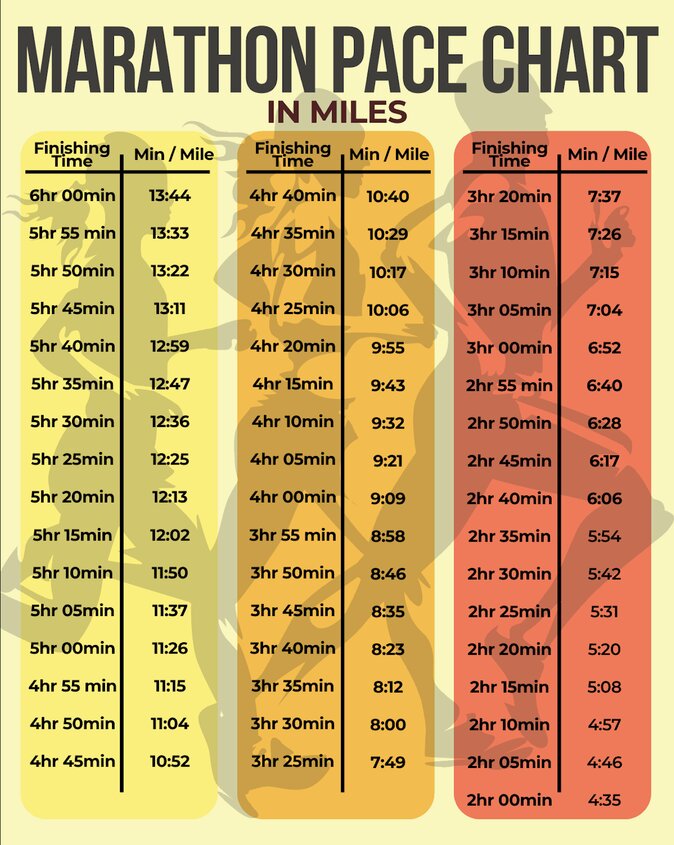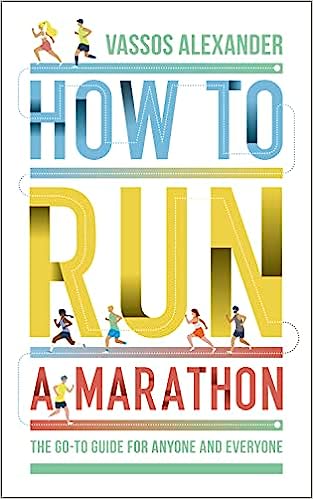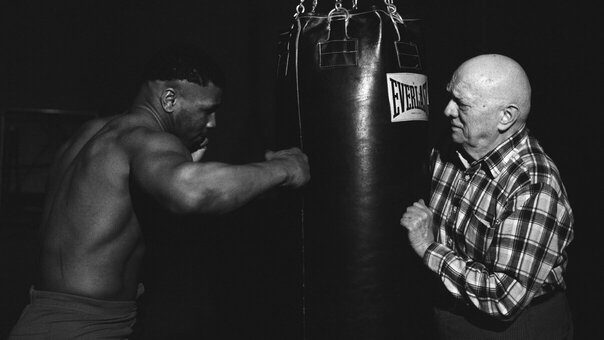Greek lyric poet Archilochus once said, “We don’t rise to the level of our expectations; we fall to the level of our training.” We don’t rise to the level of our wishes and dreams; we fall to the level of our commitment to achieving our dreams and goals. Sports is a great analogy for the power of preparation and training. Running a full (42.2 KM) marathon is somewhat tough have done a couple of them. I ran nine in 2023 and six in 2022. It is tough, but the level of follow-through is somewhat directly connected to your level of training. One’s eventual finish time is determined, among other factors, by the pace at which you run and the pace you run is based on your level of training before the race. As the marathon pace chart below shows, running a 3-hour marathon requires running at a pace of 6:52 for a mile. Hence, your finish time in any marathon can be pre-determined; you have to maintain that pace for the duration of the run.

The marathon is one of the most egalitarian sports; you can’t technically cheat. As American general George S. Patton Jr. often said, “He who sweats more in training bleeds less in battle.’ As in the marathon race, the same is also true in life. Your result in life is proportional to the level of commitment, consistency and resolve you have to achieve your goals. It is going to get tough with time, but one has got to trust the process, keep showing up for training, and prioritize your rest (self-care), and you will be fine.
How to Run a Marathon 1
There’s nothing fairer than the marathon. Nothing quite as egalitarian. Not in sport, and not in life. Simply this: train hard enough and you’ll finish it.
Often the hardest thing is getting out in the first place. Plus, it really doesn’t matter what’s behind that front door, a stately home or a bedsit. On the start line, you’d rather be a well-trained student in second-hand shoes than a billionaire with all the latest gear who’s been too busy to put in the miles. Every time you set out on a training run, you’re writing a cheque to your future self – and you’ll cash them all on Race Day.

Nobody ever regretted training properly for a marathon
In the marathon, you won’t be let down by a lack of skill. You won’t be let down by team-mates. It doesn’t matter how big your house is, how many friends you have, or how funny you are. It’s just a dance, you being led by the distance. Put in the time, put in the miles, respect it – and you’ll be just fine. In many ways, the training is everything. Running, racing, life, it’s always about the journey rather than the destination.
As Dr. Seuss rather wonderfully puts it: You have brains in your head, and feet in your shoes. You can steer yourself any direction you choose. And when things start to happen, don’t worry, don’t stew. Just go right along. You’ll start happening too.
Be realistic about how much time you can commit to training and set your goals accordingly;
•If you want to run faster, you have to run faster;
•If you must miss a session, try to make sure it’s an easy one;
•Respect the taper – less is best;
•Yes, the race is the destination, but please be sure to enjoy the journey.
“You can map out a fight plan or a life plan, but when the action starts, it may not go the way you planned, and you’re down to your reflexes – that means your [preparation:]. That’s where your roadwork shows. If you cheated on that in the dark of the morning, well, you’re going to get found out now, under the bright lights.” ― Joe Frazier
We play the way we train 2
“ For cyclists and other endurance athletes, though, pain is unavoidable, and how you handle it is intimately tied to how well you perform.”
The limits of endurance running, according to physiologists, could be quantified with three parameters: You might think the best test of maximal endurance is fairly obvious: a race. But race performance depends on highly variable factors like pacing. You may have the greatest endurance in the world, but if you’re an incurable optimist who can’t resist starting out at a sprint (or a coward who always sets off at a jog), your race times will never accurately reflect what you’re physically capable of.
- Aerobic capacity, also known as VO2max, which is analogous to the size of a car’s engine;
- Running economy, which is an efficiency measure like gas mileage; and
- Lactate threshold, which dictates how much of your engine’s power you can sustain for long periods of time.
You might think the best test of maximal endurance is fairly obvious: a race. But race performance depends on highly variable factors like pacing. You may have the greatest endurance in the world, but if you’re an incurable optimist who can’t resist starting out at a sprint (or a coward who always sets off at a jog), your race times will never accurately reflect what you’re physically capable of.
“A runner is a miser, spending the pennies of his energy with great stinginess, constantly wanting to know how much he has spent and how much longer he will be expected to pay. He wants to be broke at precisely the moment he no longer needs his coin.” – John L. Parker Jr. ,Once a Runner
Meditations
Daily Calm with Tamara Levitt – A Gentle Container
There are times when what we are feeling feels too heavy to hold, and on those days, our instinct is to turn away from our difficult emotions. One of the problems of running from our emotions is that we can’t outrun what runs in our hearts. We may push our hurt far away to a place that feels safe and buried, but at some point, it will rise to the surface.
By repressing emotions, we lose the opportunity to develop confidence that we can hold our pain. Soothing ourselves with our distractions of choice can temporarily soften the edges of what hurts. But within us lies a strong living container that we want to get to know. When we are courageous enough to face our vulnerable feelings, when we choose to get quiet and pay attention, even when it’s hard.
What we discover is that there is a world within us that is strong enough to hold our pain. It is strong enough to hold grief and loss, uncertainty and change. And the more we strengthen this inner container the more we learn to trust that we can face the challenges we meet in life. We must first get to know our pain before we soothe it.
“To heal you have to get to the root of the wound and kiss it all the way up”― Rupi Kaur, the sun and her flowers
Daily Jay with Jay Shetty – Get What You Need
Shankar graduated from the pre-college program at the Juilliard School, where she was a private violin student of Itzhak Perlman. When she was a teenager, she injured a tendon in her left hand, ending her musical career. She felt lost without her violin; her entire identity was wrapped up in it. As Shankar eventually discovered, there is more than one way to get what you really want in life.
When we land on a dream or desire, it is easy to think it is the only way to fulfill it. When Maya had to give up the violin, she was convinced that she’d never find anything that engaged her so fully, yet she did. While helping her parents clean out their basement one day, she came across an old psychology textbook. She started reading and couldn’t stop; she was captivated and went on to become an accomplished cognitive psychologist.
While the violin was the path she wanted, it wasn’t what she needed. She needed to feel enlivened and challenged. Ultimately, she realized that this other path also led to profound meaning and satisfaction. Today, she is the host and executive producer of the podcast A Slight Change of Plans.
As much as you want that dream to come true, it may not be the dream that is meant for you. If that is the case, you must search for what is beneath the dream. You have to identify what is the core value that matters most, and you’ve got to be open to exploration. There is more than one avenue to your true destination.
Daily Trip with Jeff Warren – Effortless
Meditation is more about learning what it takes to come back.
Podcast
- Jerry Seinfeld and Maria Popova — The Tim Ferriss Show
All the best in your quest to get better. Don’t Settle: Live with Passion



Comments are closed.